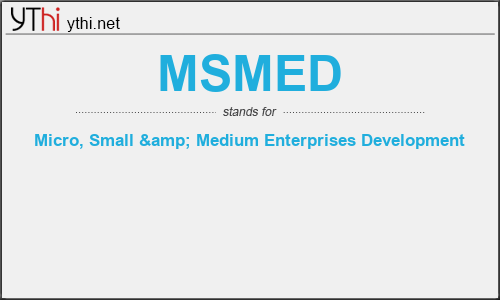What does MSMED mean? What is the full form of MSMED?
The full form of MSMED is Micro, Small & Medium Enterprises Development.
Small businesses, including those run by women and young entrepreneurs, are being hit hardest by the economic fall-out of the pandemic. Unprecedented lockdown measures enacted to contain the spread of the coronavirus have resulted in supply chain disruptions and a massive drop in demand in most sectors.
To continue playing their crucial role in creating decent jobs and improving livelihoods, small businesses depend more than ever on an enabling business environment, including support for access to finance, information, and markets.
Let’s not forget that these enterprises, which generally employ fewer than 250 persons, are the backbone of most economies worldwide and play a key role in developing countries.
According to the data provided by the International Council for Small Business (ICSB), formal and informal Micro-, Small and Medium-sized Enterprises (MSMEs) make up over 90% of all firms and account, on average, for 70% of total employment and 50% of GDP.
That is why the General Assembly declared 27 June Micro-, Small and Medium-sized Enterprises Day, to raise public awareness of their contribution to sustainable development and the global economy.
Small and Medium Enterprises (SMEs) play a major role in most economies, particularly in developing countries. SMEs account for the majority of businesses worldwide and are important contributors to job creation and global economic development. They represent about 90% of businesses and more than 50% of employment worldwide. Formal SMEs contribute up to 40% of national income (GDP) in emerging economies. These numbers are significantly higher when informal SMEs are included. According to our estimates, 600 million jobs will be needed by 2030 to absorb the growing global workforce, which makes SME development a high priority for many governments around the world. In emerging markets, most formal jobs are generated by SMEs, which create 7 out of 10 jobs. However, access to finance is a key constraint to SME growth, it is the second most cited obstacle facing SMEs to grow their businesses in emerging markets and developing countries.
SMEs are less likely to be able to obtain bank loans than large firms; instead, they rely on internal funds, or cash from friends and family, to launch and initially run their enterprises. The International Finance Corporation (IFC) estimates that 65 million firms, or 40% of formal micro, small and medium enterprises (MSMEs) in developing countries, have an unmet financing need of $5.2 trillion every year, which is equivalent to 1.4 times the current level of the global MSME lending. East Asia And Pacific accounts for the largest share (46%) of the total global finance gap and is followed by Latin America and the Caribbean (23%) and Europe and Central Asia (15%). The gap volume varies considerably region to region. Latin America and the Caribbean and the Middle East and North Africa regions, in particular, have the highest proportion of the finance gap compared to potential demand, measured at 87% and 88%, respectively. About half of formal SMEs don’t have access to formal credit. The financing gap is even larger when micro and informal enterprises are taken into account.
MSMED
means
Micro, Small & Medium Enterprises Development![]()
Translate Micro, Small & Medium Enterprises Development to other language.


Leave a Reply
You must be logged in to post a comment.